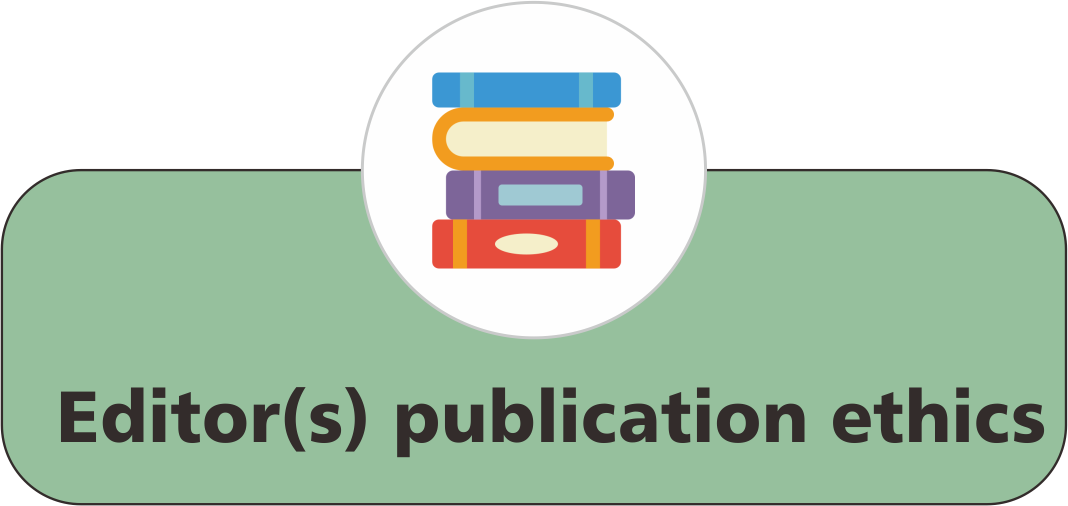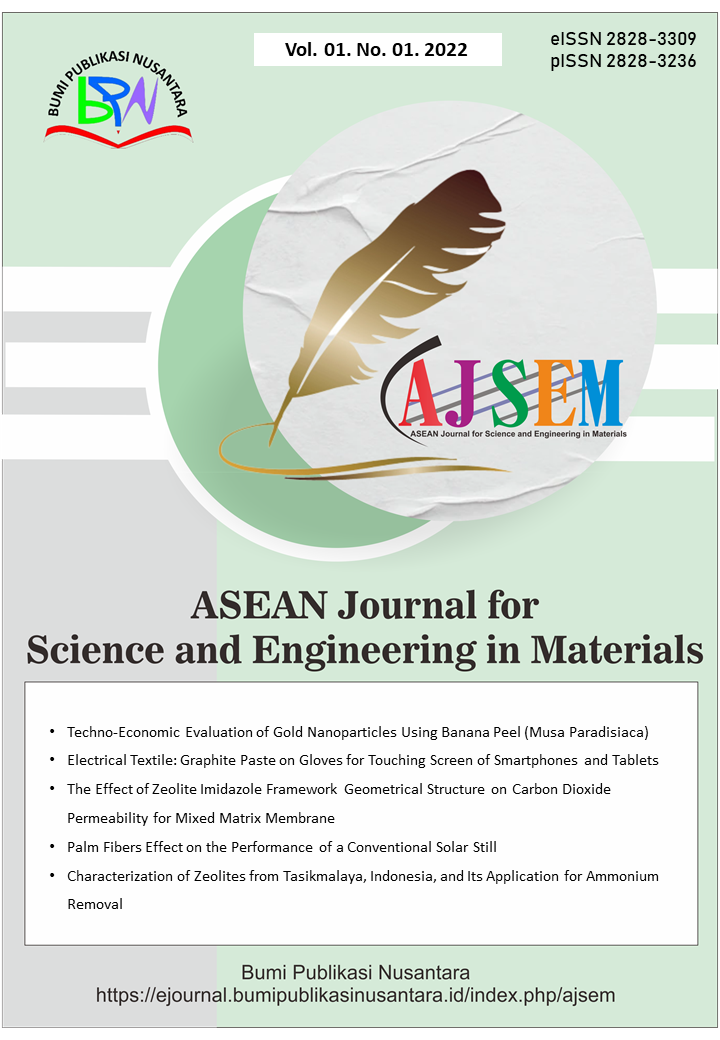Exploring Diverse Substrates for Enhanced Water Splitting: Tailoring Energy Conversion and Storage through Specific Qualities with Its Limitations
 ), H. Habibullah(2), Muhammad Irfan(3), Ali Hassan(4), Benish Habib(5), Shabbar Abbas(6), Muhammad Zakiullah Shafique(7),
), H. Habibullah(2), Muhammad Irfan(3), Ali Hassan(4), Benish Habib(5), Shabbar Abbas(6), Muhammad Zakiullah Shafique(7),
(1) Government College University Lahore
(2) Minhaj University
(3) Government College University Lahore
(4) Government College University Lahore
(5) Agriculture University Faisalabad
(6) Khawaja Fareed University of Engineering and Information Technology
(7) Khawaja Fareed University of Engineering and Information Technology
 Corresponding Author
Corresponding Author
Abstract
Keywords
References
Ahn, J., Hong, S., Shim, Y. S., and Park, J. (2020). Electroplated functional materials with 3D nanostructures defined by advanced optical lithography and their emerging applications. Applied Sciences, 10(24), 8780.
Aldhaher, A., Rabiee, N., and Iravani, S. (2023). Exploring the synergistic potential of MXene-MOF hybrid composites: A perspective on synthesis, properties, and applications. Hybrid Advances, 5, 100131.
Aljibori, H. S., Alamiery, A., and Kadhum, A. A. H. (2023). Advances in corrosion protection coatings: A comprehensive review. International Journal of Corrosion and Scale Inhibition, 12(4), 1476-1520.
Allangawi, A., Ayub, K., Gilani, M. A., Imran, M., and Mahmood, T. (2024). Transition metal loaded carbon penta-belt SACs for hydrogen and oxygen evolution reactions and identification of systematic DFT method to characterize the main interacting orbital for non-periodic system. International Journal of Hydrogen Energy, 53, 989-998.
Al-Naggar, A. H., Shinde, N. M., Kim, J. S., and Mane, R. S. (2023). Water splitting performance of metal and non-metal-doped transition metal oxide electrocatalysts. Coordination Chemistry Reviews, 474, 214864.
Alwin, S., and Sahaya Shajan, X. (2020). Aerogels: Promising nanostructured materials for energy conversion and storage applications. Materials for Renewable and Sustainable Energy, 9(2), 7.
An, L., Feng, J., Zhang, Y., Wang, R., Liu, H., Wang, G. C., and Xi, P. (2019). Epitaxial heterogeneous interfaces on N‐NiMoO4/NiS2 nanowires/nanosheets to boost hydrogen and oxygen production for overall water splitting. Advanced Functional Materials, 29(1), 1805298.
Ansón-Casaos, A., Sanahuja-Parejo, O., Hernández-Ferrer, J., Benito, A. M., and Maser, W. K. (2020). Carbon nanotube film electrodes with acrylic additives: Blocking electrochemical charge transfer reactions. Nanomaterials, 10(6), 1078.
Boamah, M. D., Lozier, E. H., Kim, J., Ohno, P. E., Walker, C. E., Miller III, T. F., and Geiger, F. M. (2019). Energy conversion via metal nanolayers. Proceedings of the National Academy of Sciences, 116(33), 16210-16215.
Bosch, M., Zhang, M., and Zhou, H. C. (2014). Increasing the stability of metal-organic frameworks. Advances in Chemistry, 2014(182327.10), 1155.
Boyes, W. K., Thornton, L. L., Al-Abed, S. R., Andersen, C. P., Bouchard, D. C., Burgess, R. M., and Zucker, R. M. (2017). A comprehensive framework for evaluating the environmental health and safety implications of engineered nanomaterials. Critical Reviews in Toxicology, 47(9), 771-814.
Cao, L. M., Hu, Y. W., Tang, S. F., Iljin, A., Wang, J. W., Zhang, Z. M., and Lu, T. B. (2018). Fe‐CoP electrocatalyst derived from a bimetallic Prussian Blue analogue for large‐current‐density oxygen evolution and overall water splitting. Advanced Science, 5(10), 1800949.
Cazorla-Amorós, D. (2014). Grand challenges in carbon-based materials research. Frontiers in Materials, 1, 6.
Chen, H., Jiang, D. E., Yang, Z., and Dai, S. (2022). Engineering nanostructured interfaces of hexagonal boron nitride-based materials for enhanced catalysis. Accounts of Chemical Research, 56(1), 52-65.
Chen, J., Ren, B., Cui, H., and Wang, C. (2020). Constructing pure phase tungsten‐based bimetallic carbide nanosheet as an efficient bifunctional electrocatalyst for overall water splitting. Small, 16(23), 1907556.
Chen, P., Zhou, T., Zhang, M., Tong, Y., Zhong, C., Zhang, N., and Xie, Y. (2017a). 3D nitrogen‐anion‐decorated nickel sulfides for highly efficient overall water splitting. Advanced Materials, 29(30), 1701584.
Chen, S., Takata, T., and Domen, K. (2017). Particulate photocatalysts for overall water splitting. Nature Reviews Materials, 2(10), 1-17.
Cheng, G., Kou, T., Zhang, J., Si, C., Gao, H., and Zhang, Z. (2017). O22-/O-functionalized oxygen-deficient Co3O4 nanorods as high performance supercapacitor electrodes and electrocatalysts towards water splitting. Nano Energy, 38, 155-166.
Cherevan, A. S., Nandan, S. P., Roger, I., Liu, R., Streb, C., and Eder, D. (2020). Polyoxometalates on functional substrates: concepts, synergies, and future perspectives. Advanced Science, 7(8), 1903511.
Choi, H., Surendran, S., Sim, Y., Je, M., Janani, G., Choi, H., and Sim, U. (2022). Enhanced electrocatalytic full water-splitting reaction by interfacial electric field in 2D/2D heterojunction. Chemical Engineering Journal, 450, 137789.
Concina, I., Ibupoto, Z. H., and Vomiero, A. (2017). Semiconducting metal oxide nanostructures for water splitting and photovoltaics. Advanced Energy Materials, 7(23), 1700706.
Danish, M. S. S., Bhattacharya, A., Stepanova, D., Mikhaylov, A., Grilli, M. L., Khosravy, M., and Senjyu, T. (2020). A systematic review of metal oxide applications for energy and environmental sustainability. Metals, 10(12), 1604.
Deng, S., Zhong, Y., Zeng, Y., Wang, Y., Wang, X., Lu, X., and Tu, J. (2018). Hollow TiO2@ Co9S8 core–branch arrays as bifunctional electrocatalysts for efficient oxygen/hydrogen production. Advanced Science, 5(3), 1700772.
Dharmarajan, N. P., Vidyasagar, D., Yang, J. H., Talapaneni, S. N., Lee, J., Ramadass, K., and Vinu, A. (2024). Bio‐inspired supramolecular self‐assembled carbon nitride nanostructures for photocatalytic water splitting. Advanced Materials, 36(2), 2306895.
Dong, C., Kou, T., Gao, H., Peng, Z., and Zhang, Z. (2018). Eutectic‐derived mesoporous Ni‐Fe‐O nanowire network catalyzing oxygen evolution and overall water splitting. Advanced Energy Materials, 8(5), 1701347.
Dou, Y., Zhang, W., and Kaiser, A. (2020). Electrospinning of metal–organic frameworks for energy and environmental applications. Advanced Science, 7(3), 1902590.
Du, Y., Li, B., Xu, G., and Wang, L. (2023). Recent advances in interface engineering strategy for highly‐efficient electrocatalytic water splitting. InfoMat, 5(1), e12377.
Fanady, B., Song, W., Peng, R., Wu, T., and Ge, Z. (2020). Efficiency enhancement of organic solar cells enabled by interface engineering of sol-gel zinc oxide with an oxadiazole-based material. Organic Electronics, 76, 105483.
Fang, M., Dong, G., Wei, R., and Ho, J. C. (2017). Hierarchical nanostructures: design for sustainable water splitting. Advanced Energy Materials, 7(23), 1700559.
Fareza, A. R., Nugroho, F. A. A., Abdi, F. F., and Fauzia, V. (2022). Nanoscale metal oxides–2D materials heterostructures for photoelectrochemical water splitting—a review. Journal of Materials Chemistry A, 10(16), 8656-8686.
Feng, L. L., Yu, G., Wu, Y., Li, G. D., Li, H., Sun, Y., and Zou, X. (2015). High-index faceted Ni3S2 nanosheet arrays as highly active and ultrastable electrocatalysts for water splitting. Journal of the American Chemical Society, 137(44), 14023-14026.
Fester, J., García-Melchor, M., Walton, A. S., Bajdich, M., Li, Z., Lammich, L., and Lauritsen, J. V. (2017). Edge reactivity and water-assisted dissociation on cobalt oxide nanoislands. Nature Communications, 8(1), 14169.
Genuzio, F., Menteş, T. O., Freindl, K., Spiridis, N., Korecki, J., and Locatelli, A. (2020). Chemistry-dependent magnetic properties at the FeNi oxide–metal interface. Journal of Materials Chemistry C, 8(17), 5777-5785.
Grandell, L., and Höök, M. (2015). Assessing rare metal availability challenges for solar energy technologies. Sustainability, 7(9), 11818-11837.
Groß, J., Kühlborn, J., and Opatz, T. (2020). Applications of xylochemistry from laboratory to industrial scale. Green Chemistry, 22(14), 4411-4425.
Guo, Y., Tang, J., Wang, Z., Kang, Y. M., Bando, Y., and Yamauchi, Y. (2018). Elaborately assembled core-shell structured metal sulfides as a bifunctional catalyst for highly efficient electrochemical overall water splitting. Nano Energy, 47, 494-502.
Han, N., Yang, K. R., Lu, Z., Li, Y., Xu, W., Gao, T., and Sun, X. (2018). Nitrogen-doped tungsten carbide nanoarray as an efficient bifunctional electrocatalyst for water splitting in acid. Nature Communications, 9(1), 924.
Harish, V., Ansari, M. M., Tewari, D., Yadav, A. B., Sharma, N., Bawarig, S., and Barhoum, A. (2023). Cutting-edge advances in tailoring size, shape, and functionality of nanoparticles and nanostructures: A review. Journal of the Taiwan Institute of Chemical Engineers, 149, 105010.
Hegazy, H. H., Sana, S. S., Ramachandran, T., Kumar, Y. A., Kulurumotlakatla, D. K., Abd-Rabboh, H. S., and Kim, S. C. (2023). Covalent organic frameworks in supercapacitors: Unraveling the pros and cons for energy storage. Journal of Energy Storage, 74, 109405.
Hisatomi, T., and Domen, K. (2019). Reaction systems for solar hydrogen production via water splitting with particulate semiconductor photocatalysts. Nature Catalysis, 2(5), 387-399.
Hu, J., Al-Salihy, A., Zhang, B., Li, S., and Xu, P. (2022). Mastering the D-band center of iron-series metal-based electrocatalysts for enhanced electrocatalytic water splitting. International Journal of Molecular Sciences, 23(23), 15405.
Huang, S., Meng, Y., He, S., Goswami, A., Wu, Q., Li, J., and Wu, M. (2017). N‐, O‐, and S‐tridoped carbon‐encapsulated Co9S8 nanomaterials: efficient bifunctional electrocatalysts for overall water splitting. Advanced Functional Materials, 27(17), 1606585.
Huang, X., Yang, G., Li, S., Wang, H., Cao, Y., Peng, F., and Yu, H. (2022). Noble-metal-based high-entropy-alloy nanoparticles for electrocatalysis. Journal of Energy Chemistry, 68, 721-751.
Huang, Y., Sun, Y., Zheng, X., Aoki, T., Pattengale, B., Huang, J., and Gu, J. (2019). Atomically engineering activation sites onto metallic 1T-MoS2 catalysts for enhanced electrochemical hydrogen evolution. Nature Communications, 10(1), 982.
Hussain, M. A., Joseph, N., Kang, O., Cho, Y. H., Um, B. H., and Kim, J. W. (2016). Supported metal nanoparticles: their catalytic applications to selective alcohol oxidation. Applied Chemistry for Engineering, 27(3), 227-238.
Iqbal, A. A., Sakib, N., Iqbal, A. P., and Nuruzzaman, D. M. (2020). Graphene-based nanocomposites and their fabrication, mechanical properties and applications. Materialia, 12, 100815.
Jakhar, M., Kumar, A., Ahluwalia, P. K., Tankeshwar, K., and Pandey, R. (2022). Engineering 2D materials for photocatalytic water-splitting from a theoretical perspective. Materials, 15(6), 2221.
Jayaseelan, S. S., Bhuvanendran, N., Xu, Q., and Su, H. (2020). Co3O4 nanoparticles decorated Polypyrrole/carbon nanocomposite as efficient bi-functional electrocatalyst for electrochemical water splitting. International Journal of Hydrogen Energy, 45(7), 4587-4595.
Jeon, T. Y., Kim, D. J., Park, S. G., Kim, S. H., and Kim, D. H. (2016). Nanostructured plasmonic substrates for use as SERS sensors. Nano Convergence, 3, 1-20.
Jiang, W. J., Tang, T., Zhang, Y., and Hu, J. S. (2020). Synergistic modulation of non-precious-metal electrocatalysts for advanced water splitting. Accounts of Chemical Research, 53(6), 1111-1123.
Jiao, Y. Q., Yan, H. J., Tian, C. G., and Fu, H. G. (2022). Structure engineering and electronic modulation of transition metal interstitial compounds for electrocatalytic water splitting. Accounts of Materials Research, 4(1), 42-56.
Jin, H., Wang, J., Su, D., Wei, Z., Pang, Z., and Wang, Y. (2015). In situ cobalt–cobalt oxide/N-doped carbon hybrids as superior bifunctional electrocatalysts for hydrogen and oxygen evolution. Journal of the American Chemical Society, 137(7), 2688-2694.
Jin, Y., Wang, H., Li, J., Yue, X., Han, Y., Shen, P. K., and Cui, Y. (2016). Porous MoO2 nanosheets as non-noble bifunctional electrocatalysts for overall water splitting. Advanced Materials, 28(19), 3785-3790.
Kawasaki, S., Takahashi, R., Yamamoto, T., Kobayashi, M., Kumigashira, H., Yoshinobu, J., and Lippmaa, M. (2016). Photoelectrochemical water splitting enhanced by self-assembled metal nanopillars embedded in an oxide semiconductor photoelectrode. Nature Communications, 7(1), 11818.
Kim, M., Kwon, B. H., Joo, C. W., Cho, M. S., Jang, H., Kim, Y. J., and Jung, Y. S. (2022). Metal oxide charge transfer complex for effective energy band tailoring in multilayer optoelectronics. Nature Communications, 13(1), 75.
Kleinschmidt, D., Fernandes, M. S., Mork, M., Meyer, A. A., Krischel, J., Anakhov, M. V., and Pich, A. (2020). Enhanced catalyst performance through compartmentalization exemplified by colloidal L-proline modified microgel catalysts. Journal of Colloid and Interface Science, 559, 76-87.
Kou, Z., Zhang, L., Ma, Y., Liu, X., Zang, W., Zhang, J., and Wang, J. (2019). 2D carbide nanomeshes and their assembling into 3D microflowers for efficient water splitting. Applied Catalysis B: Environmental, 243, 678-685.
Kundu, S., Bramhaiah, K., and Bhattacharyya, S. (2020). Carbon-based nanomaterials: in the quest of alternative metal-free photocatalysts for solar water splitting. Nanoscale Advances, 2(11), 5130-5151.
Lee, J. S. (2012). Photoelectrochemical water splitting for solar hydrogen production over semiconductor nanostructures. Rapid Communication in Photoscience: RCP, 1(2), 39-39.
Lei, C., Wang, Y., Hou, Y., Liu, P., Yang, J., Zhang, T., and Feng, X. (2019). Efficient alkaline hydrogen evolution on atomically dispersed Ni–N x Species anchored porous carbon with embedded Ni nanoparticles by accelerating water dissociation kinetics. Energy and Environmental Science, 12(1), 149-156.
Li, F., and Xue, M. (2016). Two-dimensional transition metal dichalcogenides for electrocatalytic energy conversion applications. Two-dimensional Materials-Synthesis, Characterization and Potential Applications, 64-84.
Li, J., Wang, Y., Zhou, T., Zhang, H., Sun, X., Tang, J., and Zheng, G. (2015). Nanoparticle superlattices as efficient bifunctional electrocatalysts for water splitting. Journal of the American Chemical Society, 137(45), 14305-14312.
Li, M., Zhu, Y., Wang, H., Wang, C., Pinna, N., and Lu, X. (2019). Ni strongly coupled with Mo2C encapsulated in nitrogen‐doped carbon nanofibers as robust bifunctional catalyst for overall water splitting. Advanced Energy Materials, 9(10), 1803185.
Li, X., Hao, X., Abudula, A., and Guan, G. (2016). Nanostructured catalysts for electrochemical water splitting: current state and prospects. Journal of Materials Chemistry A, 4(31), 11973-12000.
Li, X., Liu, L., Ren, X., Gao, J., Huang, Y., and Liu, B. (2020). Microenvironment modulation of single-atom catalysts and their roles in electrochemical energy conversion. Science Advances, 6(39), eabb6833.
Li, Y., Zhang, H., Jiang, M., Zhang, Q., He, P., and Sun, X. (2017). 3D self‐supported Fe‐doped Ni2P nanosheet arrays as bifunctional catalysts for overall water splitting. Advanced Functional Materials, 27(37), 1702513.
Liang, Q., Jin, H., Wang, Z., Xiong, Y., Yuan, S., Zeng, X., and Mu, S. (2019). Metal-organic frameworks derived reverse-encapsulation Co-NC@ Mo2C complex for efficient overall water splitting. Nano Energy, 57, 746-752.
Liao, W., Wang, S., Su, H., and Zhang, Y. (2023). Application of in situ/operando characterization techniques in heterostructure catalysts toward water electrolysis. Nano Research, 16(2), 1984-1991.
Lin, J., Wang, P., Wang, H., Li, C., Si, X., Qi, J., and Feng, J. (2019). Defect‐rich heterogeneous MoS2/NiS2 nanosheets electrocatalysts for efficient overall water splitting. Advanced Science, 6(14), 1900246.
Liu, J., Wagan, S., Dávila Morris, M., Taylor, J., and White, R. J. (2014a). Achieving reproducible performance of electrochemical, folding aptamer-based sensors on microelectrodes: challenges and prospects. Analytical Chemistry, 86(22), 11417-11424.
Liu, Y., Jiang, S., Li, S., Zhou, L., Li, Z., Li, J., and Shao, M. (2019). Interface engineering of (Ni, Fe) S2@ MoS2 heterostructures for synergetic electrochemical water splitting. Applied Catalysis B: Environmental, 247, 107-114.
Liu, Y., Wang, Y. M., Yakobson, B. I., and Wood, B. C. (2014b). Assessing carbon-based anodes for lithium-ion batteries: A universal description of charge-transfer binding. Physical Review Letters, 113(2), 028304.
Liu, Z., Zhao, Z., Zhang, W., Huang, Y., Liu, Y., Wu, D., and Chou, S. (2022). Toward high‐performance lithium‐oxygen batteries with cobalt‐based transition metal oxide catalysts: Advanced strategies and mechanical insights. InfoMat, 4(4), e12260.
Loera-Serna, S., and Ortiz, E. (2016). Catalytic applications of metal-organic frameworks. Luis N, Advanced Catalytic Materials-Photocatalysis and Other Current Trends, IntechOpen, 2016, 95-122.
Luneau, M., Guan, E., Chen, W., Foucher, A. C., Marcella, N., Shirman, T., and Friend, C. M. (2020). Enhancing catalytic performance of dilute metal alloy nanomaterials. Communications Chemistry, 3(1), 46.
Luo, X., Ji, P., Wang, P., Cheng, R., Chen, D., Lin, C., and Mu, S. (2020). Interface engineering of hierarchical branched Mo‐doped Ni3S2/NixPy hollow heterostructure nanorods for efficient overall water splitting. Advanced Energy Materials, 10(17), 1903891.
Masood ul Hasan, I., Peng, L., Mao, J., He, R., Wang, Y., Fu, J., and Qiao, J. (2021). Carbon‐based metal‐free catalysts for electrochemical CO2 reduction: Activity, selectivity, and stability. Carbon Energy, 3(1), 24-49.
Mayer, M. T., Lin, Y., Yuan, G., and Wang, D. (2013). Forming heterojunctions at the nanoscale for improved photoelectrochemical water splitting by semiconductor materials: Case studies on hematite. Accounts of Chemical Research, 46(7), 1558-1566.
Melkiyur, I., Rathinam, Y., Kumar, P. S., Sankaiya, A., Pitchaiya, S., Ganesan, R., and Velauthapillai, D. (2023). A comprehensive review on novel quaternary metal oxide and sulphide electrode materials for supercapacitor: Origin, fundamentals, present perspectives and future aspects. Renewable and Sustainable Energy Reviews, 173, 113106.
Meyer, K., Ranocchiari, M., and van Bokhoven, J. A. (2015). Metal organic frameworks for photo-catalytic water splitting. Energy and Environmental Science, 8(7), 1923-1937.
Mowbray, D. J., Martinez, J. I., Calle-Vallejo, F., Rossmeisl, J., Thygesen, K. S., Jacobsen, K. W., and Nørskov, J. K. (2011). Trends in metal oxide stability for nanorods, nanotubes, and surfaces. The Journal of Physical Chemistry C, 115(5), 2244-2252.
Naghavi, S. S., Emery, A. A., Hansen, H. A., Zhou, F., Ozolins, V., and Wolverton, C. (2017). Giant onsite electronic entropy enhances the performance of ceria for water splitting. Nature Communications, 8(1), 285.
Nasir, S., Hussein, M. Z., Zainal, Z., Yusof, N. A., Zobir, S. A. M., and Alibe, I. M. (2019). Potential valorization of by-product materials from oil palm: A review of alternative and sustainable carbon sources for carbon-based nanomaterials synthesis. BioResources, 14(1), 2352-2388.
Nasrollahzadeh, M., Sajjadi, M., Iravani, S., and Varma, R. S. (2021). Carbon-based sustainable nanomaterials for water treatment: State-of-art and future perspectives. Chemosphere, 263, 128005.
Nemiwal, M., Gosu, V., Zhang, T. C., and Kumar, D. (2021a). Metal organic frameworks as electrocatalysts: Hydrogen evolution reactions and overall water splitting. International Journal of Hydrogen Energy, 46(17), 10216-10238.
Nemiwal, M., Zhang, T. C., and Kumar, D. (2021b). Graphene-based electrocatalysts: Hydrogen evolution reactions and overall water splitting. International Journal of Hydrogen Energy, 46(41), 21401-21418.
Pellegrino, P., Bramanti, A. P., Farella, I., Cascione, M., De Matteis, V., Della Torre, A., and Rinaldi, R. (2022). Pulse-atomic force lithography: A powerful nanofabrication technique to fabricate constant and varying-depth nanostructures. Nanomaterials, 12(6), 991.
Peng, J., He, Y., Zhou, C., Su, S., and Lai, B. (2021). The carbon nanotubes-based materials and their applications for organic pollutant removal: A critical review. Chinese Chemical Letters, 32(5), 1626-1636.
Peng, S., Gong, F., Li, L., Yu, D., Ji, D., Zhang, T., and Ramakrishna, S. (2018). Necklace-like multishelled hollow spinel oxides with oxygen vacancies for efficient water electrolysis. Journal of the American Chemical Society, 140(42), 13644-13653.
Qiu, B., Cai, L., Zhang, N., Tao, X., and Chai, Y. (2020). A ternary dumbbell structure with spatially separated catalytic sites for photocatalytic overall water splitting. Advanced Science, 7(17), 1903568.
Raza, A., Zhang, X., Ali, S., Cao, C., Rafi, A. A., and Li, G. (2022). Photoelectrochemical energy conversion over 2D materials. Photochem, 2(2), 272-298.
Reza, M. S., Ahmad, N. B. H., Afroze, S., Taweekun, J., Sharifpur, M., and Azad, A. K. (2023). Hydrogen Production from Water Splitting through Photocatalytic Activity of Carbon‐Based Materials. Chemical Engineering and Technology, 46(3), 420-434.
Rocío-Bautista, P., Taima-Mancera, I., Pasán, J., and Pino, V. (2019). Metal-organic frameworks in green analytical chemistry. Separations, 6(3), 33.
Roger, I., Shipman, M. A., and Symes, M. D. (2017). Earth-abundant catalysts for electrochemical and photoelectrochemical water splitting. Nature Reviews Chemistry, 1(1), 1-13.
Ronge, E., Cottre, T., Welter, K., Smirnov, V., Ottinger, N. J., Finger, F., ... and Jooss, C. (2020). Stability and degradation mechanismof si-based photocathodes for water splitting with ultrathin TiO2 protection layer. Zeitschrift für Physikalische Chemie, 234(6), 1171-1184.
Safdari, M., and Al-Haik, M. S. (2018). A review on polymeric nanocomposites: effect of hybridization and synergy on electrical properties. Carbon-Based Polymer Nanocomposites for Environmental and Energy Applications, 2018, 113-146.
Sahoo, D. P., Das, K. K., Mansingh, S., Sultana, S., and Parida, K. (2022). Recent progress in first row transition metal Layered double hydroxide (LDH) based electrocatalysts towards water splitting: A review with insights on synthesis. Coordination Chemistry Reviews, 469, 214666.
Sahoo, P. K., Bisoi, S. R., Huang, Y. J., Tsai, D. S., and Lee, C. P. (2021). 2D-layered non-precious electrocatalysts for hydrogen evolution reaction: Fundamentals to applications. Catalysts, 11(6), 689.
Shah, S. S. A., Javed, M. S., Najam, T., Molochas, C., Khan, N. A., Nazir, M. A., and Bao, S. J. (2022). Metal oxides for the electrocatalytic reduction of carbon dioxide: Mechanism of active sites, composites, interface and defect engineering strategies. Coordination Chemistry Reviews, 471, 214716.
Shen, S., Sun, K., Zhang, H., and Liang, Y. (2014). Advanced catalysis and nanostructure design for solar energy conversion. Advances in Condensed Matter Physics, 2014, 1-4.
Shkodenko, L., Kassirov, I., and Koshel, E. (2020). Metal oxide nanoparticles against bacterial biofilms: Perspectives and limitations. Microorganisms, 8(10), 1545.
Stoica, I., Sava, I., Bulai, G., Stoian, G., Strat, M., Gurlui, S., and Oprisan, B. (2020). Development and morphological characterization of novel polyimide/metal nano hybrid materials. Materiale Plastice, 57(2), 94-103.
Sun, H., Yan, Z., Liu, F., Xu, W., Cheng, F., and Chen, J. (2020). Self‐supported transition‐metal‐based electrocatalysts for hydrogen and oxygen evolution. Advanced Materials, 32(3), 1806326.
Sun, L., Ji, X., Zhou, Y., Li, H., Zhai, W., Chen, B., ... and Wang, T. (2023). An overview of hydrogen production from Al-based materials. Nanotechnology Reviews, 12(1), 20220521.
Sun, L., Luo, Q., Dai, Z., and Ma, F. (2021a). Material libraries for electrocatalytic overall water splitting. Coordination Chemistry Reviews, 444, 214049.
Sun, X., Bao, J., Li, K., Argyle, M. D., Tan, G., Adidharma, H., and Ning, P. (2021b). Advance in using plasma technology for modification or fabrication of carbon‐based materials and their applications in environmental, material, and energy fields. Advanced Functional Materials, 31(7), 2006287.
Swesi, A. T., Masud, J., Liyanage, W. P., Umapathi, S., Bohannan, E., Medvedeva, J., and Nath, M. (2017). Textured NiSe2 film: bifunctional electrocatalyst for full water splitting at remarkably low overpotential with high energy efficiency. Scientific Reports, 7(1), 2401.
Tabakaev, R. B., Astafyev, A. V., Kazakov, A. V., and Zavorin, A. S. (2015). Low-temperature catalytic conversion of carbonaceous materials. MATEC Web of Conferences. Vol. 23: Heat and Mass Transfer in the Thermal Control System of Technical and Technological Energy Equipment.—Les Ulis, 2015, 23, 10394.
Tabor, D. P., Roch, L. M., Saikin, S. K., Kreisbeck, C., Sheberla, D., Montoya, J. H., and Aspuru-Guzik, A. (2018). Accelerating the discovery of materials for clean energy in the era of smart automation. Nature Reviews Materials, 3(5), 5-20.
Tachibana, Y., Vayssieres, L., and Durrant, J. R. (2012). Artificial photosynthesis for solar water-splitting. Nature Photonics, 6(8), 511-518.
Tachikawa, T., and Majima, T. (2014). Metal oxide mesocrystals with tailored structures and properties for energy conversion and storage applications. NPG Asia Materials, 6(5), e100-e100.
Tamayo, L., Palza, H., Bejarano, J., and Zapata, P. A. (2019). Polymer composites with metal nanoparticles: synthesis, properties, and applications. Polymer Composites with Functionalized Nanoparticles, 2019,249-286.
Tang, D., Mabayoje, O., Lai, Y., Liu, Y., and Mullins, C. B. (2017a). Enhanced photoelectrochemical performance of porous Bi2MoO6 photoanode by an electrochemical treatment. Journal of The Electrochemical Society, 164(6), H299.
Tang, M. H., Chakthranont, P., and Jaramillo, T. F. (2017). Top-down fabrication of fluorine-doped tin oxide nanopillar substrates for solar water splitting. RSC Advances, 7(45), 28350-28357.
Tang, Y. J., Zheng, H., Wang, Y., Zhang, W., and Zhou, K. (2021). Laser‐induced annealing of metal–organic frameworks on conductive substrates for electrochemical water splitting. Advanced Functional Materials, 31(31), 2102648.
Tao, L., Wang, Y., Zou, Y., Zhang, N., Zhang, Y., Wu, Y., and Wang, S. (2020). Charge transfer modulated activity of carbon‐based electrocatalysts. Advanced Energy Materials, 10(11), 1901227.
Toma, F. M., Sartorel, A., Carraro, M., Bonchio, M., and Prato, M. (2011). Dendron-functionalized multiwalled carbon nanotubes incorporating polyoxometalates for water-splitting catalysis. Pure and Applied Chemistry, 83(8), 1529-1542.
Toshima, N. (2013). Metal nanoparticles for energy conversion. Pure and Applied Chemistry, 85(2), 437-451.
Uwaya, G. E., and Fayemi, O. E. (2021). Enhanced electrocatalytic detection of choline based on CNTs and metal oxide nanomaterials. Molecules, 26(21), 6512.
Vanka, S., Zeng, G., Deutsch, T. G., Toma, F. M., and Mi, Z. (2022). Long-term stability metrics of photoelectrochemical water splitting. Frontiers in Energy Research, 10, 840140.
Venditti, I. (2022). Metal nanoparticles–polymers hybrid materials I. Polymers, 14(15), 3117.
Vivekanandhan, S., Schreiber, M., Muthuramkumar, S., Misra, M., and Mohanty, A. K. (2017). Carbon nanotubes from renewable feedstocks: A move toward sustainable nanofabrication. Journal of Applied Polymer Science, 134(4), 1-15.
Wang, B., Iocozzia, J., Zhang, M., Ye, M., Yan, S., Jin, H., and Lin, Z. (2019). The charge carrier dynamics, efficiency and stability of two-dimensional material-based perovskite solar cells. Chemical Society Reviews, 48(18), 4854-4891.
Wang, H., Cao, Y., Sun, C., Zou, G., Huang, J., Kuai, X., and Gao, L. (2017). Strongly coupled molybdenum carbide on carbon sheets as a bifunctional electrocatalyst for overall water splitting. ChemSusChem, 10(18), 3540-3546.
Wang, H., Chen, Z. N., Wu, D., Cao, M., Sun, F., Zhang, H., and Cao, R. (2021a). Significantly enhanced overall water splitting performance by partial oxidation of Ir through Au modification in core–shell alloy structure. Journal of the American Chemical Society, 143(12), 4639-4645.
Wang, H., Lee, H. W., Deng, Y., Lu, Z., Hsu, P. C., Liu, Y., and Cui, Y. (2015). Bifunctional non-noble metal oxide nanoparticle electrocatalysts through lithium-induced conversion for overall water splitting. Nature Communications, 6(1), 7261.
Wang, J., Liao, T., Wei, Z., Sun, J., Guo, J., and Sun, Z. (2021b). Heteroatom‐doping of non‐noble metal‐based catalysts for electrocatalytic hydrogen evolution: An electronic structure tuning strategy. Small Methods, 5(4), 2000988.
Wang, S., Xu, L., and Lu, W. (2018). Synergistic effect: Hierarchical Ni3S2@ Co (OH) 2 heterostructure as efficient bifunctional electrocatalyst for overall water splitting. Applied Surface Science, 457, 156-163.
Wang, X. H., Ling, Y., Wu, B., Li, B. L., Li, X. L., Lei, J. L., ... and Luo, H. Q. (2021c). Doping modification, defects construction, and surface engineering: Design of cost-effective high-performance electrocatalysts and their application in alkaline seawater splitting. Nano Energy, 87, 106160.
Wang, X., Vasileff, A., Jiao, Y., Zheng, Y., and Qiao, S. Z. (2019). Electronic and structural engineering of carbon‐based metal‐free electrocatalysts for water splitting. Advanced Materials, 31(13), 1803625.
Wu, R., Xiao, B., Gao, Q., Zheng, Y. R., Zheng, X. S., Zhu, J. F., and Yu, S. H. (2018). A janus nickel cobalt phosphide catalyst for high‐efficiency neutral‐pH water splitting. Angewandte Chemie, 130(47), 15671-15675.
Wu, Y., Li, G. D., Liu, Y., Yang, L., Lian, X., Asefa, T., and Zou, X. (2016). Overall water splitting catalyzed efficiently by an ultrathin nanosheet‐built, hollow Ni3S2‐based electrocatalyst. Advanced Functional Materials, 26(27), 4839-4847.
Wu, Y., Tao, X., Qing, Y., Xu, H., Yang, F., Luo, S., and Lu, X. (2019). Cr‐Doped FeNi–P nanoparticles encapsulated into N‐doped carbon nanotube as a robust bifunctional catalyst for efficient overall water splitting. Advanced Materials, 31(15), 1900178.
Xu, H., Shang, H., Wang, C., and Du, Y. (2020). Surface and interface engineering of noble-metal-free electrocatalysts for efficient overall water splitting. Coordination Chemistry Reviews, 418, 213374.
Xu, S., Chansai, S., Stere, C., Inceesungvorn, B., Goguet, A., Wangkawong, K., ... and Fan, X. (2019). Sustaining metal–organic frameworks for water–gas shift catalysis by non-thermal plasma. Nature Catalysis, 2(2), 142-148.
Xu, X., Li, W., Wang, X., and Dou, S. X. (2011). Superconducting properties of graphene doped magnesium diboride. Applications of High-Tc Superconductivity, 201-218.
Xu, Y., Dong, K., Jie, Y., Adelhelm, P., Chen, Y., Xu, L., Yu, Z. J. A. E. M. (2022). Promoting mechanistic understanding of lithium deposition and solid‐electrolyte interphase (SEI) formation using advanced characterization and simulation methods: recent progress, limitations, and future perspectives. 12(19), 2200398.
Xu, Y., Fan, K., Zou, Y., Fu, H., Dong, M., Dou, Y., Al-Mamun, M. J. N. (2021). Rational design of metal oxide catalysts for electrocatalytic water splitting. 13(48), 20324-20353.
Xu, Z., Wang, H., Wen, Y., Li, W., Sun, C., He, Y., and Zou, Z. (2018). Balancing catalytic activity and interface energetics of electrocatalyst-coated photoanodes for photoelectrochemical water splitting. ACS Applied Materials and Interfaces, 10(4), 3624-3633.
Xue, Y., Chen, S., Yu, J., Bunes, B. R., Xue, Z., Xu, J., and Zang, L. (2020). Nanostructured conducting polymers and their composites: Synthesis methodologies, morphologies and applications. Journal of Materials Chemistry C, 8(30), 10136-10159.
Xue, Z. H., Su, H., Yu, Q. Y., Zhang, B., Wang, H. H., Li, X. H., and Chen, J. S. (2017). Janus Co/CoP nanoparticles as efficient Mott–Schottky electrocatalysts for overall water splitting in wide pH range. Advanced Energy Materials, 7(12), 1602355.
Yan, L., Zhang, B., Zhu, J., Li, Y., Tsiakaras, P., and Shen, P. K. (2020a). Electronic modulation of cobalt phosphide nanosheet arrays via copper doping for highly efficient neutral-pH overall water splitting. Applied Catalysis B: Environmental, 265, 118555.
Yan, Z., Liu, H., Hao, Z., Yu, M., Chen, X., and Chen, J. (2020b). Electrodeposition of (hydro) oxides for an oxygen evolution electrode. Chemical Science, 11(39), 10614-10625.
Yang, L., Liu, R., and Jiao, L. (2020). Electronic redistribution: construction and modulation of interface engineering on CoP for enhancing overall water splitting. Advanced Functional Materials, 30(14), 1909618.
Yang, Q., Xu, Q., and Jiang, H.-L. (2017). Metal–organic frameworks meet metal nanoparticles: synergistic effect for enhanced catalysis. Chemical Society Reviews, 46(15), 4774-4808.
Yang, Y., Xiong, Y., Zeng, R., Lu, X., Krumov, M., Huang, X., and Abruña, H. D. (2021). Operando methods in electrocatalysis. ACS Catalysis, 11(3), 1136-1178.
Yang, Y., Yao, H., Yu, Z., Islam, S. M., He, H., Yuan, M., and Kanatzidis, M. G. (2019). Hierarchical nanoassembly of MoS2/Co9S8/Ni3S2/Ni as a highly efficient electrocatalyst for overall water splitting in a wide pH range. Journal of the American Chemical Society, 141(26), 10417-10430.
You, B., Liu, X., Hu, G., Gul, S., Yano, J., Jiang, D. E., and Sun, Y. (2017). Universal surface engineering of transition metals for superior electrocatalytic hydrogen evolution in neutral water. Journal of the American Chemical Society, 139(35), 12283-12290.
Yu, F., Zhou, H., Huang, Y., Sun, J., Qin, F., Bao, J., and Ren, Z. (2018). High-performance bifunctional porous non-noble metal phosphide catalyst for overall water splitting. Nature Communications, 9(1), 2551.
Yuan, C. Z., Hui, K. S., Yin, H., Zhu, S., Zhang, J., Wu, X. L., and Hui, K. N. (2021). Regulating intrinsic electronic structures of transition-metal-based catalysts and the potential applications for electrocatalytic water splitting. ACS Materials Letters, 3(6), 752-780.
Zhang, F., Yu, L., Wu, L., Luo, D., and Ren, Z. (2021). Rational design of oxygen evolution reaction catalysts for seawater electrolysis. Trends in Chemistry, 3(6), 485-498.
Zhang, J., Wang, T., Pohl, D., Rellinghaus, B., Dong, R., Liu, S., and Feng, X. (2016a). Interface engineering of MoS2/Ni3S2 heterostructures for highly enhanced electrochemical overall‐water‐splitting activity. Angewandte Chemie, 128(23), 6814-6819.
Zhang, J., Xia, Z., and Dai, L. (2015). Carbon-based electrocatalysts for advanced energy conversion and storage. Science Advances, 1(7), e1500564.
Zhang, L., Cui, P., Yang, H., Chen, J., Xiao, F., Guo, Y., and Liu, B. (2016b). Metal–organic frameworks as promising photosensitizers for photoelectrochemical water splitting. Advanced Science, 3(1), 1500243.
Zhang, S., Gao, G., Hao, J., Wang, M., Zhu, H., Lu, S., and Zhao, Y. (2019). Low-electronegativity vanadium substitution in cobalt carbide induced enhanced electron transfer for efficient overall water splitting. ACS Applied Materials and Interfaces, 11(46), 43261-43269.
Zhang, X., Dong, C. L., Wang, Y., Chen, J., Arul, K. T., Diao, Z., and Shen, S. (2020). Regulating crystal structure and atomic arrangement in single-component metal oxides through electrochemical conversion for efficient overall water splitting. ACS Applied Materials and Interfaces, 12(51), 57038-57046.
Zhang, X., Fang, X., Zhu, K., Yuan, W., Jiang, T., Xue, H., and Tian, J. (2022). Fe-doping induced electronic structure reconstruction in Ni-based metal-organic framework for improved energy-saving hydrogen production via urea degradation. Journal of Power Sources, 520, 230882.
Zhong, Y., Xia, X., Shi, F., Zhan, J., Tu, J., and Fan, H. J. (2016). Transition metal carbides and nitrides in energy storage and conversion. Advanced Science, 3(5), 1500286.
Zhou, Y. N., Zhu, Y. R., Chen, X. Y., Dong, B., Li, Q. Z., and Chai, Y. M. (2021). Carbon–based transition metal sulfides/selenides nanostructures for electrocatalytic water splitting. Journal of Alloys and Compounds, 852, 156810.
Zou, X., and Zhang, Y. (2015). Noble metal-free hydrogen evolution catalysts for water splitting. Chemical Society Reviews, 44(15), 5148-5180.
辻豪, 渡邊一正, 實石陽一, 鈴木宏隆, 岩元和敏, 吉田章一郎, and 妹尾学. (1999). バイポーラ膜中の水の電離に対する金属酸化物水和物の触媒効果. 日本化学会誌 (化学と工業化学), 1999(7), 441-444.
Article Metrics
Abstract View : 805 times
: 805 times Download : 296 times
Download : 296 times
Refbacks
- There are currently no refbacks.
Copyright (c) 2024 Bumi Publikasi Nusantara

This work is licensed under a Creative Commons Attribution-ShareAlike 4.0 International License.









